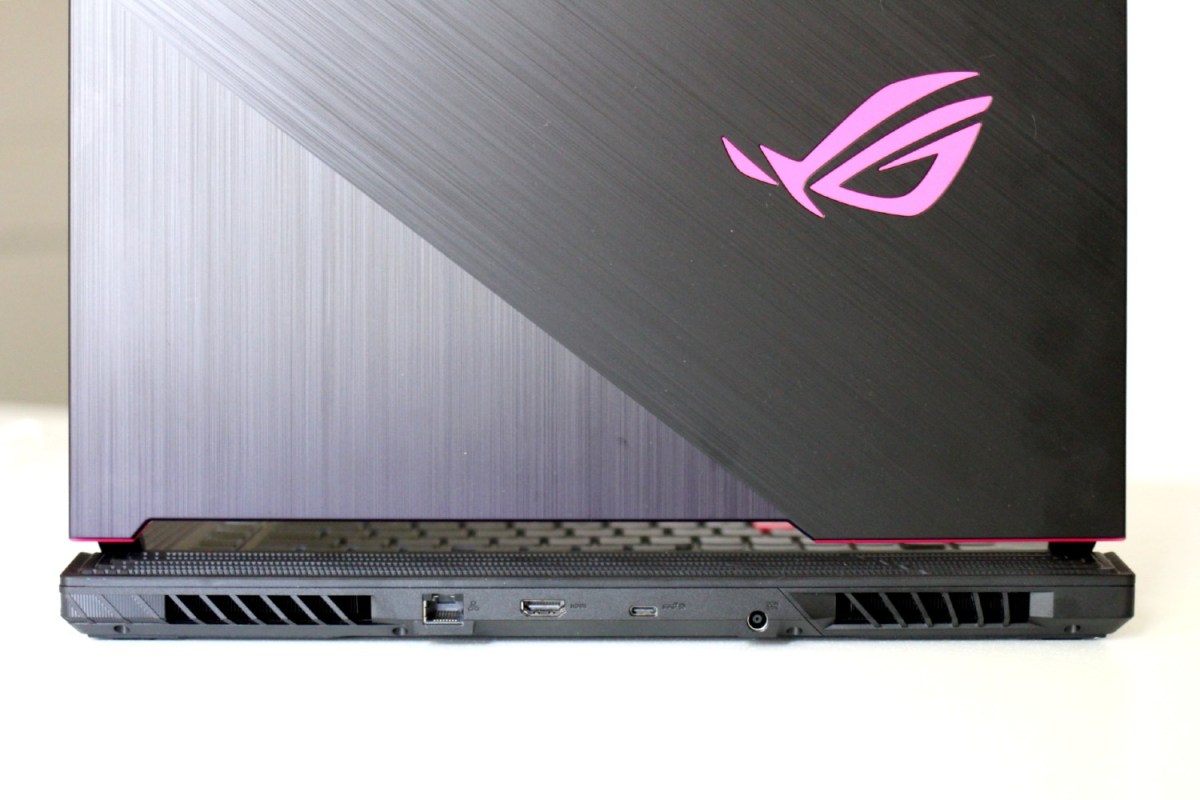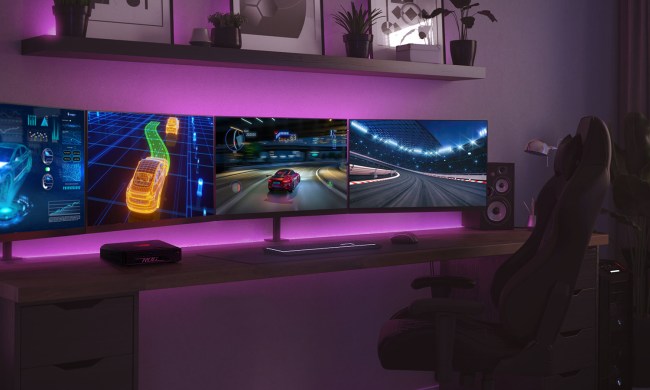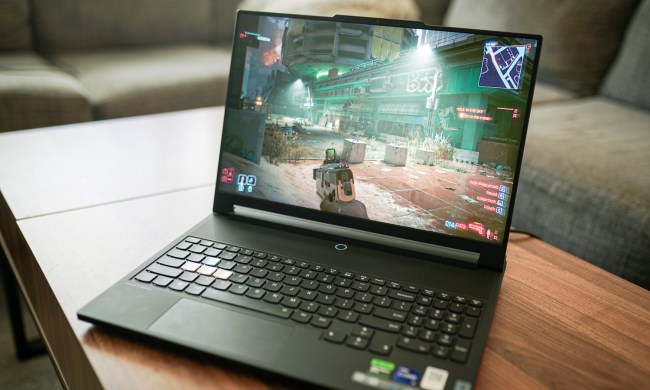- Solid gaming performance
- RGB lighting is distinctive
- High refresh rate
- Good thermals
- Thick and clunky
- No webcam or secure login
Higher refresh rates have become the big talking point for top gaming laptops in recent years. Thanks to the gains in performance, even budget-level gaming laptops are getting refresh rates higher than 60Hz.
Asus’ flashy new gaming laptop, the $1,000 ROG Strix G15, is one of the least expensive laptops you can get with a 144Hz screen. My review unit came with just an Nvidia GTX 1650 Ti, the entry-level option for serious mobile gaming.
Is that enough horsepower to properly power a 144Hz display? Let’s find out.
Design

Asus says it designed the ROG Strix G15 in collaboration with BMW, which sounds interesting at first. Unfortunately, car-inspired aesthetics are nothing new — it’s been in the DNA of gaming gear for many years.
The design collaboration results in a plastic gaming laptop with lots of ridges, lines, and textured materials. This is fake brushed metal that you can feel on your fingertips. Still, I prefer the look over something gaudier like the Acer Predator Helios 300.
ROG Strix G15 is made entirely out of plastic, though the ROG Strix G15 is rather tank-like in its structural integrity. The lid is the only weak spot. It’s easy to bend or flex, and the hinge will slam the lid shut unless it’s open at least 50% of the way.
The wraparound light bar brightens up your desk with a splash of RGB color.
My unit came in all black, and Asus says that provides it a “professional persona.” Honestly, no one’s going to mistake it for anything other than a gaming laptop. Laptops like the Razer Blade or MSI GS66 Stealth will fit in better at a meeting (if you still have those, that is).
What the ROG Strix G15 does have is lights. Lots of lights. The keyboard has per-key backlighting, and that’s just the beginning. The ROG Strix G15 features a “wraparound light bar,” which brightens up your desk with a splash of RGB color. The LEDs themselves are hidden from direct view, leaving a diffused glow beneath. It’s a nice effect that makes the Strix G15 stand out from the sea of other black gaming laptops.
The ROG Strix G15 isn’t thin or light. It weighs 5.7 pounds and is just under a full inch thick. Even the Dell G3 Gaming Laptop, which is chunky in its own right, beats the Strix G15 in portability. The Strix G15 also has a large footprint, thanks to the placement of the ports on the rear. To compensate, the laptop features a massive chin bezel. There’s a significant gap between the display and the rest of the chassis. That means the screen sits up higher when open than some 17-inch laptops.

The ROG Strix G15 has a typical keyboard layout, though there are some eccentricities. I like the brightly colored WASD keys, and the extra function keys along the side. Asus has also pulled a few important keys out of the function row, such as volume control. Unfortunately, the buttons they used are squishy and feel imprecise.
The touchpad is fine for a gaming laptop in this price range. It has a smooth surface and tracks well enough, though Asus opted for old-school, left, and right physical buttons, which feels out of date and cuts into usable touchpad space. As with many Asus laptops, you can turn on a digital number pad on the touchpad, since the keyboard lacks one. It works reasonably well, but accountants won’t be pleased.
Ports

The ROG Strix G15 follows the trend of putting many of lesser-used ports in the back. That’s where your video out options are, whether via HDMI 2.0 or USB-C. The USB-C port isn’t Thunderbolt 3 and doesn’t support power delivery. You’ll need to stick with the proprietary barrel plug for charging, which is also located on the rear next to an RJ45 Ethernet jack.
The only ports on the sides of the device are three USB-A 3.2 Gen 2 ports, along with a headphone jack. The right side is completely port-free.
The Strix G15 doesn’t include a webcam, like most Asus gaming laptops sold today. This decision makes some sense in a vacuum, as Asus knows gamers who stream will rely on a better external webcam. However, this decision is poorly timed given the sudden popularity of work-from-home.
Lastly, the Strix G15 doesn’t include an IR camera or a fingerprint reader for secure Windows Hello logins. It does include the latest Wi-Fi 6 for connectivity, along with Bluetooth 5.0.
Display

The display is what makes the ROG Strix G15 an interesting gaming laptop. But not because the panel’s image quality is all that impressive. It’s subpar by just about every measure, and the colors are the biggest detriment.
It only hits 65% of the sRGB color space, which is meager compared to the 98% of a laptop like the Razer Blade or MSI GS66 Stealth. Even the affordable Dell G5 SE hits 98%, as do midrange laptops like the Lenovo Yoga C640. It has a slightly green tint to it, making my skin tone look downright sickly in a YouTube video we shot. In games, it’s less noticeable, though.
It’s not a bright panel, maxing out at only 278 nits, but the matte finish helps avoid harsh reflections. Let’s be honest, you’ll probably be playing games in more dimly-lit rooms anyways.
The refresh rate is the true stand-out feature of the display. Just a year or two ago, 144Hz was the standard for high-end gaming laptops like the Razer Blade. These days, 300Hz screens have risen the standard, while the ROG Strix G15 can be configured up to a 240Hz. It’s still rare on gaming laptops at this price point, making the ROG Strix G15’s screen a highlight of its gaming experience.
Game performance

The ROG Strix G15 may only have a paltry Nvidia GTX 1650 Ti onboard for graphics, but don’t underestimate it. Modern, 3D titles play smoothly on it, even with settings maxed out. It can hit 64 fps (frames per second) in Fortnite, 56 in Battlefield V, and 63 in Civilization VI. Those are plenty high, though they don’t make much use of the 144Hz refresh rate. If you only play on max settings, you won’t notice the difference between this and a standard 60Hz screen.
But it really shines when you turn graphics settings down a bit. Frame rates jump up significantly, and you start to feel the true power of a higher refresh rate. At Medium settings, Civilization VI plays at 108 fps, while Fortnite hits 86 fps at “High” settings (which is one down from Epic). Interestingly, it matches the performance of the equally-equipped Dell XPS 15 in almost every game for $600 less.
The problem? Not all games fare as well as those lighter titles. Battlefield V is a good example, which still only averages 60 fps at Medium settings. Of course, you can drop it down to Low if you really want to break 60 fps, but that’s no fun. Assassin’s Creed Odyssey is an even better example. At its middle setting, “High,” the game averages just 42 fps on the ROG Strix G15. At Ultra High, it’s down to a measly 23 fps.
Even while gaming, the system keeps surface temperatures surprisingly cool.
That’s why Asus classifies this laptop for “e-sports.” If you try to play something more demanding — or even just want to see more graphical detail in your games — the ROG Strix G15 isn’t right for you.
That’s where the AMD-powered Dell G5 SE makes a compelling case for itself. The AMD Radeon RX 5600M featured in the Dell G5 SE far outperforms the Nvidia GTX 1650 Ti — in some cases, by as much as 48%. Then again, Dell sells the G5 SE without a 144Hz in lower configurations. For a certain type of gamer, the high refresh rate of the ROG Strix G15 is more well-suited.
Of course, Asus offers more powerful configurations of this laptop too. An attractive option, for example, might be the $1,500 model, which comes with an RTX 2070, a 240Hz refresh rate, 16GB of RAM, and 1TB of solid-state storage. Razer offers a very similar configuration of the Blade for a whopping $500 more.
Furthermore, the ROG Strix G15 has an advantage in cooling over smaller gaming laptops. Even while gaming, the system keeps surface temperatures surprisingly cool. It’s at the expense of fan noise (and chassis thickness), but you’ll appreciate the cooling temperatures on the palm rests after long gaming sessions.
Content creation performance
In performance outside of gaming, the Dell G5 SE once again poses a problem in the comparison. It features an eight-core processor, versus the six-core option in the ROG Strix G15. That means significantly better performance in highly-threaded applications. With its focus on gaming, that’s might not be a deal-breaker for the ROG Strix G15.
My review unit came with the Intel Core i7-10750H, 8GB of RAM, and a 512GB SSD. It’s performance in Cinebench R20 had me a bit worried. It’s single-core score lagged behind even puny 15-watt laptops like the Microsoft Surface Book 3. Thanks to the two extra cores, the Dell G5 SE was 26% faster in Cinebench’s multi-core test.
That translated directly to how fast the ROG Strix G15 performed at video encoding too. The Dell G5 SE was 27% faster at encoding a 4K movie trailer to H.265 in Handbrake. Clearly, the ROG Strix G15 wasn’t designed with this type of workload in mind, but if you want to do some content creation on the side (that doesn’t depend on the quality of the screen), the ROG Strix G15 can get the job done.
The ROG Strix G15 also comes with an empty M.2 slot for future expansion. You can also upgrade the RAM up to 32GB.
Battery life

The ROG Strix G15 isn’t cut out for long sessions away from the wall.
Three hours and 50 minutes in our light web browsing test is not good, even for a gaming laptop. The Dell G5 SE lasts over six hours in this same test.
The Strix G15 did prove itself in the video playback test, which loops a local 1080p video clip until the battery dies. The Strix G15 lasted eight hours, even beating the Dell G5 SE by an hour and a half. Unfortunately, this doesn’t represent the battery life of a typical workload.
In my daily work setup, consisting of a dozen browser tabs and a few applications, it lasted around four hours on a single charge. There are far better gaming laptops for battery life.
Our take
The Asus ROG Strix G15 is a good choice for a certain type of gamer. It’s the cheapest 144Hz gaming laptops you can buy, and offers just enough performance to make use of it in some games. The image quality of the display is disappointing, and it lacks a lot of the bells and whistles of spendier gaming laptops. Most gamers will be happier upgrading to a laptop with at least an Nvidia GTX 1660 Ti, but the ROG Strix G15 is a good starting point if you’re strapped for cash.
Are there any alternatives?
The Dell G5 SE is a problem for the ROG Strix G15. It’s more powerful in just about every way, and if you can bump up the price to $1,050, it even comes with a 144Hz screen. The ROG Strix G15 offers that higher refresh rate at cheaper configurations, though, and comes with a more polished-looking chassis.
The $920 Lenovo IdeaPad 3i is one of the only cheap gaming laptops with a high refresh rate. It’s 120Hz rather than 144Hz, but you’ll likely not notice the difference. It comes with a slower Core i5 processor, but is also slightly cheaper than the ROG Strix G15.
How long will it last?
The ROG Strix G15 is a well-built laptop, but its graphics card isn’t the fastest. In a few years, you may find that newer games struggle to play smoothly on it. However, the ability to upgrade the RAM and storage is a plus for the longevity of the ROG Strix G15.
Asus offers standard one-year warranties on its laptops. After that, you’re on your own.
Should you buy it?
Yes. If you’re an e-sports gamer who cares more about frame rates than graphical detail, the ROG Strix G15 offers just enough performance to you by.




